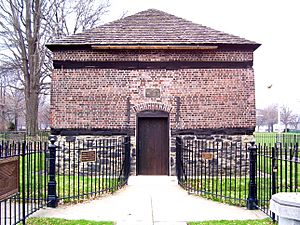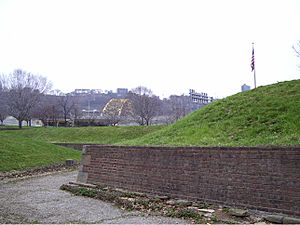Fort Pitt Museum facts for kids

Museum exterior in 2014
|
|
| Lua error in Module:Location_map at line 420: attempt to index field 'wikibase' (a nil value). | |
| Established | 1969 |
|---|---|
| Location | Pittsburgh, Allegheny County, Pennsylvania, United States |
|
Fort Pitt Museum
|
|
|
U.S. Historic district
Contributing property |
|
| Part of | Pittsburgh Renaissance Historic District (ID13000252) |
| Designated CP | May 2, 2013 |
The Fort Pitt Museum is a cool place to visit in downtown Pittsburgh, Pennsylvania. It's an indoor and outdoor museum managed by the Heinz History Center. This museum sits right where the Monongahela River and Allegheny River meet to form the mighty Ohio River.
This special spot is surrounded by Point State Park. This park is named after the important piece of land between the rivers. This area was super important for controlling the Ohio River Valley and western Pennsylvania. It played a big role before, during, and after the French and Indian War and the American Revolution.
The museum itself is built inside a recreated part of Fort Pitt. The British originally built this fort in 1758. You can also see an outline of Fort Duquesne nearby. The museum mainly focuses on Fort Pitt's role in the French and Indian War. It also shares details about the fort's part in the American Revolution, the Whiskey Rebellion, and how Pittsburgh began.
The Pennsylvania Historical and Museum Commission first opened and ran the museum. It closed for a short time in 2009 due to budget cuts. But the Heinz History Center took over and reopened it in April 2010.
Contents
Fort Pitt: A Key Historical Site
Building Fort Pitt


Fort Pitt was a very important fort built in 1758. It was constructed during the French and Indian War right next to where Fort Duquesne once stood. The French had built Fort Duquesne earlier in the war. It became a major target because of its great location near the rivers.
In 1755, a British attempt to capture Fort Duquesne, known as the Braddock expedition, failed badly. The French soldiers at Fort Duquesne also strongly fought off a British attack in September 1758. However, the French later left and destroyed their fort when General John Forbes's British expedition arrived in November.
Why the British Succeeded
The Forbes expedition succeeded where others had failed. This was partly because of the Treaty of Easton. In this treaty, local American Indians agreed to stop helping the French. These Native American groups, mainly the Delawares and Shawnees, made this deal. They understood that the British army would leave the area after the war ended.
The Native Americans wanted a trading post there, but they did not want a British army fort. However, the British built a new fort anyway. They named it Fort Pitt, honoring William Pitt the Elder.
Pontiac's Rebellion and Fort Pitt
Because the British stayed, local Delawares and Shawnees joined Pontiac's Rebellion in 1763. This was an effort to push the British out of their lands. The Native Americans began to surround Fort Pitt on June 22, 1763. But the fort was too strong for them to capture by force.
During talks, the commander of Fort Pitt gave two Delaware representatives blankets that had been near people with smallpox. This was done hoping to make the surrounding Native Americans sick and end the siege. It's not fully clear how much this specific act affected the situation. Smallpox outbreaks had already affected Native American populations for many years, causing many deaths.
On August 1, 1763, most of the Native Americans stopped the siege. They left to stop a British force led by Colonel Henry Bouquet. This led to the Battle of Bushy Run. Colonel Bouquet fought off the attack and reached Fort Pitt on August 10.
Fort Pitt After the Wars
After Pontiac's War, the British government no longer needed Fort Pitt as much. It was left to the local people in 1772. At that time, both Virginia and Pennsylvania claimed the Pittsburgh area. A struggle for control of the region began.
Virginians took control of Fort Pitt. For a short time in the 1770s, it was called Fort Dunmore. This was in honor of Virginia's Governor Lord Dunmore. The fort was used as a starting point for Dunmore's War in 1774.
During the American Revolutionary War, Fort Pitt was a main base for the western part of the war. After the Revolution, Fort Pitt again started to fall apart. It was finally left empty in 1792 when Fort Fayette was built to replace it. People living in the growing city of Pittsburgh used parts of the old fort to build their homes.
The Fort Pitt Blockhouse Today
A small brick building called the Blockhouse still stands in Point State Park. It's actually a type of small fort called a redoubt. This is the only original part of Fort Pitt that is still standing. It was built in 1764 and is thought to be the oldest building in western Pennsylvania.
For many years, the blockhouse was used as a home. The Daughters of the American Revolution bought it and have kept it safe for a long time. They make it open for the public to visit. Parts of Fort Pitt's foundations have also been dug up. Some sections of the fort have been rebuilt. This helps visitors to Point State Park understand how big the fort once was. The Fort Pitt Museum is located in this rebuilt section, specifically in the Monongahela Bastion.
During the American Civil War, the Fort Pitt Foundry was an important place for making weapons for the government. William Metcalf was in charge of it.
The Fort Pitt Museum Experience
Renovating Point State Park
In 2006, a big plan was announced to improve Point State Park and parts of the Fort Pitt Museum. This $25 million plan aimed to make the park's green areas better. It also planned to add more fun activities, protect historical sites, and update old facilities. The project was mostly finished in time for Pittsburgh's 250th-anniversary celebration in 2008.
Some parts of the park had not been used much since it opened in 1974. There had been issues with graffiti on park structures. Walkways had also become cracked and were breaking apart. The goal of the restoration was to make the park a great place for recreation again.
Park Improvements
Many improvements were made to the park. New pumps and pipes were put in the fountain. A seating area was created around the fountain, along with a shallow wading area for children. The river walk was restored with steps leading into the river. Information and snack kiosks were built. Restrooms were updated, and boat taxi landings were renovated. Wireless internet access points were also added.
In 2011, the waterfront area was closed for a while as stone walkways and the wharf area were being redone. They reopened later that summer.
Museum Reopening and Current Information
On August 14, 2009, the state closed the Fort Pitt Museum and three other museums. This was due to a lack of money during a budget crisis. The Senator John Heinz Regional History Center then took over managing the museum.
The Senator John Heinz History Center reopened the Fort Pitt Museum on Saturday, April 17, 2010. The History Center also manages other museums. These include a large museum in Pittsburgh's Strip District and the Meadowcroft Rockshelter and Historic Village. Meadowcroft is the oldest known site where humans lived in North America. They also manage the Western Pennsylvania Sports Museum.
Today, the Fort Pitt Museum is open to visitors seven days a week. It is open from 10 AM to 5 PM. The museum is closed only on major holidays like Christmas, New Year's Day, Thanksgiving, and Easter.



